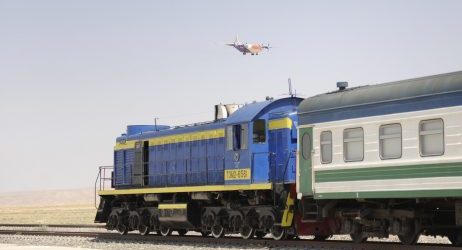From the first tracks laid in 1879 at Gyzylarbat, northwest of the capital of modern-day Turkmenistan, locomotive transport has always been central to Central Asia due to the region’s distance from the open sea. Although first set down amid the expansion of the Russian Empire, today, railways have a central role in the economic planning of the Central Asian states, especially in Kyrgyzstan and double-landlocked Uzbekistan.
Afghanistan Expansion
In Tashkent on February 2, Pakistan, Uzbekistan, and Afghanistan agreed to a roadmap for the building of a 573-kilometer route from Mazar-e-Sharif to Peshawar, via Kabul. This project, at an estimated cost of $5 billion, will open Pakistani seaports on the Arabian Gulf to Uzbekistan and continue Afghanistan’s gradual integration into the Central Asian economic system.
Within Uzbekistan, the agreement has been hailed as the “event of the century” by the chairperson of the Senate, Tanzila Narbaeva, who called it another example of Uzbekistan “actively pursuing an open and pragmatic foreign policy.”
However, such a potentially momentous accord needs to be couched in the realities of the region. There are immense infrastructural and logistical difficulties ahead for the proposed railway. The agreed route traverses the Hindu-Kush range and tops out at a whopping 3,500 meters, which would make it one of the highest railroads in the world if completed. This ambitious route design will test the supply of materials while the ability to attract laborers and companies to work in Afghanistan will not be an easy task either.
Enjoying this article? Click here to subscribe for full access. Just $5 a month.
The security situation in Afghanistan is of central concern in this regard. The Taliban have shown an interest in engaging regionally, holding talks in January with Turkmenistan over energy supply to Taliban-held areas of Afghanistan and security of the Turkmenistan-Afghanistan-Pakistan-India (TAPI) pipeline. Coupled with continuing peace negotiations between the government and the insurgents, there could be hope for the safety and viability of the complex, long-term railway project. Indeed, the commitment of Pakistan and Uzbekistan could signal their belief in the continued stability of Afghanistan.
Another big issue is the variable gauges of the railway and its connections with Uzbekistan. Uzbekistan uses exclusively the Russian, 1520mm gauge, while Pakistan uses 1676mm gauge. In 2010, Afghanistan opted to build using the international standard, 1435mm, gauge.
Russia’s Role
The gauge issue is a legacy of Russian Imperialism, a parting gift to the region which effectively means that any use of existing track must allow for reloading of cargo onto different trains at border points. Coupled with fierce debates over routes and political inertia, the incompatibility of the 1520mm gauge with neighboring tracks has hamstrung connectivity in Central Asia for decades.
The Mazar-e-Sharif-Kabul-Peshawar line is the latest in a succession of railway projects concocted by interior Central Asian states to solve the issue of access to the sea and move away from Russia’s orbit. One famous example of this is the prospective major railway connection from the Chinese port of Lanzhou to Tashkent via the city of Osh in Kyrgyzstan. Having been mooted for over 20 years, the route became operational in June 2020 with a major caveat – the Kyrgyz connection was via trucks rather than rail.
As former Soviet states have sought to extricate themselves from Moscow’s embrace, they have repeatedly butted up against the gauge issue. The railways provide an analogy of Russian influence over the countries in its neighborhood. Although the Central Asian states are in many respects desperate to gain a level of independence from their former overlord, they are held back by this and other historical connections to Russia.
The Belt and Road Connection
China’s Belt and Road Initiative (BRI) has provided an alternative center of gravity in the region. As the economic outrider of Central Asia, Kazakhstan has pressed on with the Khorgos-Aktau route from China’s border to the Caspian Sea. China has plunged billions into the creation of a “dry port” at Khorgos, which has been described as the flagship BRI initiative in Kazakhstan.
By creating a system akin to a port, which uses cranes to move cargo between tracks, Khorgos was presented by China as an opportunity to shift the center of railway freight in the region to the south of Russia and offer a way to bridge the gauge gap. The dry port also sits in a cross-border free-trade zone, which is marketed by China and Kazakhstan as a route to rapid economic growth.
However, Chinese investment with its neighbors is starting to fray at the seams. In Kazakhstan, this has manifested itself in the news that Chinese companies are taking advantage of the considerable subsidies for shipping freight through Khorgos by shipping empty containers along the route.
Enjoying this article? Click here to subscribe for full access. Just $5 a month.
Additionally, due to its proximity to Xinjiang, the borderlands around Khorgos have been drawn into the repression of Uyghurs across the border. Chinese dissidents linked to the camps have been accused of using the free-trade zone to escape from China.
Sayragul Sauytbay, an ethnic Kazakh Chinese national who fled China after having worked in the camps, was tried for crossing the Kazakhstan-China border illegally in 2019. She was released but denied asylum in Kazakhstan; she managed to get asylum along with her family in Sweden. Askar Azatbek, an official from Xinjiang who became a Kazakh citizen, was allegedly kidnapped from the Kazakh side of the free-trade zone in December 2017.
The negativity surrounding Chinese investment has been reinforced by the situation regarding the BRI-affiliated China-Pakistan Economic Corridor (CPEC). The $60 billion investment plan involving special economic zones (SEZs), rail, and ports has hit snags over issues such as corruption and security. A recent inquiry conducted by the Security and Exchange Commission of Pakistan found irregularities worth over $1.8 billion in the power sector, with 16 mostly Chinese firms involved in CPEC receiving undue subsidies and causing huge financial losses to the national exchequer.
It is unclear whether the new railway will use lines that are part of CPEC and what effect China will have on guaranteeing fast, unencumbered transit of freight. Uzbekistan announced that the Mazar-e-Sharif-Peshawar line will be financed almost entirely by the World Bank. This tacit rejection of the BRI by the least developed country in the region, Afghanistan, and by Uzbekistan, which previously worked with China on railways, points to a subtle shift in where Central Asian states look for support.
Prospects
As Central Asian horizons have expanded and non-Russian support and investment has come in, the region’s economic prospects have become increasingly multilayered. From the logistical issues of overcoming competing gauge systems and the challenges of building in inhospitable – sometimes dangerous – climates, to balancing competing interests of various powers, rail transport is another prism through which to analyze the situation in Eurasia.
The progress of the proposed railway will provide a test of how Central Asia values the BRI almost eight years after its inception in Kazakhstan. Do the negative allegations of corruption and oppression provide enough cause for concern in the region? Equally, will Russia accept the obvious economic benefits to such a railway, and having done so, will it aim to gain more control of the project?
Such an ambitious project will be a marker of how much growth and power Central Asian states have accrued, and how independent they are really prepared to be.





